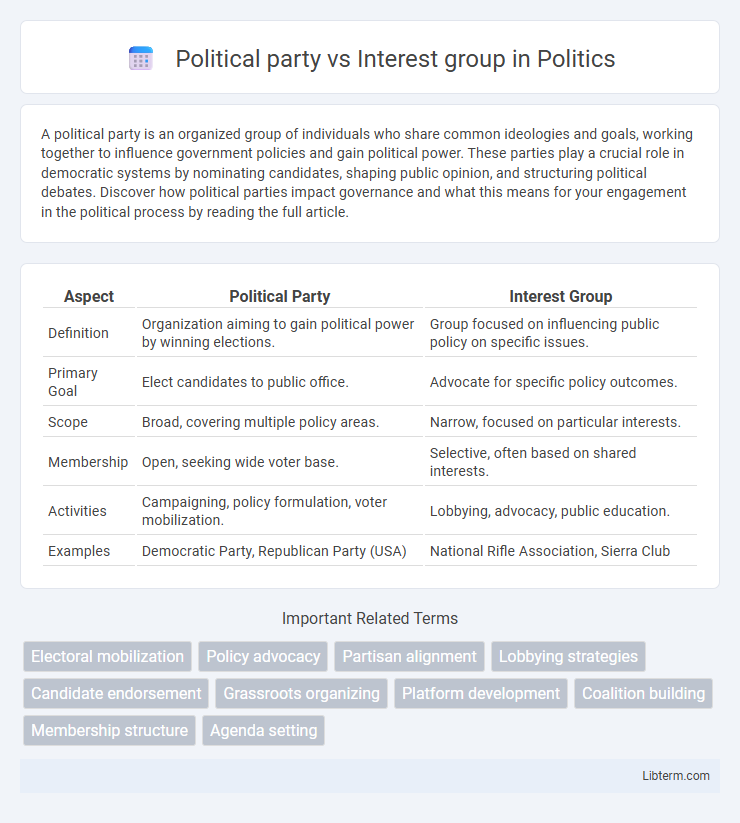A political party is an organized group of individuals who share common ideologies and goals, working together to influence government policies and gain political power. These parties play a crucial role in democratic systems by nominating candidates, shaping public opinion, and structuring political debates. Discover how political parties impact governance and what this means for your engagement in the political process by reading the full article.
Table of Comparison
| Aspect | Political Party | Interest Group |
|---|---|---|
| Definition | Organization aiming to gain political power by winning elections. | Group focused on influencing public policy on specific issues. |
| Primary Goal | Elect candidates to public office. | Advocate for specific policy outcomes. |
| Scope | Broad, covering multiple policy areas. | Narrow, focused on particular interests. |
| Membership | Open, seeking wide voter base. | Selective, often based on shared interests. |
| Activities | Campaigning, policy formulation, voter mobilization. | Lobbying, advocacy, public education. |
| Examples | Democratic Party, Republican Party (USA) | National Rifle Association, Sierra Club |
Definition of Political Parties and Interest Groups
Political parties are organized groups seeking to gain political power by fielding candidates in elections to implement their policy agendas. Interest groups, also known as advocacy or pressure groups, aim to influence public policy and decision-making without directly seeking electoral office. While political parties address a broad spectrum of issues to appeal to a wide electorate, interest groups focus on specific causes or interests, mobilizing support to shape legislation and government action.
Core Functions and Objectives
Political parties primarily aim to gain and maintain political power by nominating candidates, winning elections, and shaping government policies, focusing on broad agendas that address a wide range of public issues. Interest groups concentrate on influencing specific policy outcomes and advocate for particular causes or sectors without directly seeking political office, utilizing lobbying, research, and public campaigns. Both entities play distinct roles in democratic systems, with political parties integrating diverse interests into governance and interest groups representing targeted concerns to policymakers.
Organizational Structure Differences
Political parties have a hierarchical organizational structure with formal membership, clear leadership roles, and a broad policy platform to contest elections and govern. Interest groups feature a more decentralized or network-based structure, emphasizing specialized expertise and advocacy for specific issues without seeking electoral office. Unlike political parties, interest groups often operate through coalitions, grassroots mobilization, and targeted lobbying to influence public policy.
Influence on Policy-Making
Political parties directly influence policy-making by nominating candidates, shaping legislative agendas, and controlling government positions, which allows them to implement their platforms efficiently. Interest groups impact policy-making through targeted lobbying, mobilizing public opinion, and providing expert information to legislators to sway decisions on specific issues. While political parties aim for broad governance control, interest groups concentrate on specialized policy areas to affect regulation and legislation outcomes.
Membership and Public Participation
Political parties recruit members through broad-based platforms aimed at winning elections and governing, encouraging widespread public participation across diverse constituencies. Interest groups typically maintain more specialized, often smaller memberships focused on particular issues, mobilizing supporters to influence policy without seeking electoral office. Both entities engage the public, but parties emphasize voter turnout and candidate support while interest groups prioritize advocacy and issue-specific activism.
Strategies for Gaining Power
Political parties gain power by nominating candidates, mobilizing voters, and winning elections to control government institutions. Interest groups focus on influencing policymakers through lobbying, campaign contributions, and grassroots advocacy without directly seeking office. Both entities use strategic communication and coalition-building to shape legislation and public policy in their favor.
Role in Elections and Campaigns
Political parties directly participate in elections by nominating candidates, organizing campaigns, and mobilizing voters to gain legislative power and govern. Interest groups do not field candidates but influence elections by endorsing candidates, funding campaigns, and conducting issue-based advocacy to shape policy outcomes indirectly. Campaign contributions and voter mobilization efforts by interest groups serve to support political parties aligned with their policy goals.
Relationship with Government Institutions
Political parties aim to influence government by winning elections and holding public office, enabling direct control over legislative and executive branches. Interest groups seek to shape government policy indirectly through lobbying, advocacy, and mobilizing public opinion without seeking electoral office. While political parties integrate into government institutions as policymakers, interest groups function as external influencers targeting legislators and agency officials.
Examples in Contemporary Politics
Political parties such as the Democratic and Republican parties in the United States aim to gain governmental power by nominating candidates and influencing policy across a broad spectrum of issues. Interest groups like the National Rifle Association (NRA) and the Sierra Club focus on specific policy areas, lobbying lawmakers and mobilizing members to advocate for targeted legislative outcomes. While political parties organize electoral competition and governance, interest groups function to influence those in power without seeking office directly.
Key Differences and Similarities
Political parties primarily seek to gain political power by fielding candidates in elections, while interest groups focus on influencing policy without running for office. Both entities organize individuals around shared goals and aim to shape government decisions, but political parties have a broader agenda encompassing multiple issues, whereas interest groups typically concentrate on specific concerns. The key difference lies in their methods: political parties engage in electoral competition, whereas interest groups employ lobbying and advocacy to impact legislation.
Political party Infographic

 libterm.com
libterm.com